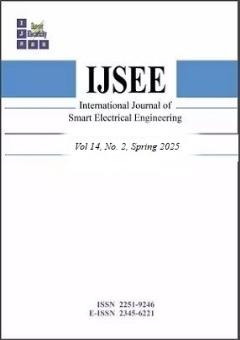Optimizing Traffic Engineering in IoT and 5G Networks Using Advanced AI and PSO Techniques
Subject Areas : International Journal of Smart Electrical Engineeringsomayeh Azizi 1 , Mohammad Reza Soltan Aghaei 2 , Hossein Ghaffarian 3
1 -
2 -
3 -
Keywords: Traffic Management, Internet of Things, 5G Networks, Particle Swarm Optimization, Machine Learning, Network Optimization,
Abstract :
The evolution of Internet of Things (IoT) and 5G networks has introduced unprecedented challenges in traffic management due to the sheer volume and dynamic nature of data transmission. Traffic engineering plays a crucial role in ensuring the efficiency and reliability of these modern networks, yet traditional methods often struggle to adapt to their dynamic and unpredictable nature. This paper addresses these challenges by proposing a novel hierarchical traffic engineering framework that integrates the synergistic capabilities of Particle Swarm Optimization (PSO) and Machine Learning (ML) techniques to enhance traffic management in IoT and 5G networks. The proposed framework operates in two interconnected layers: the lower layer leverages PSO for real-time optimization of network resources, focusing on dynamic adjustments to routing paths, bandwidth allocation, and other parameters to minimize latency, packet loss, and maximize throughput. The upper layer employs ML to analyze historical traffic data and predict future traffic patterns, enabling proactive management of network resources. This integrated dual-layer approach ensures optimal resource utilization and adherence to Quality of Service (QoS) requirements. Extensive simulations demonstrate that the proposed method significantly reduces latency, enhances throughput, and minimizes packet loss compared to traditional traffic engineering approaches. By harnessing the strengths of both PSO and ML, this framework offers a scalable and adaptive solution to the complexities of modern communication networks, contributing significantly to the state of the art in network traffic management and providing major implications f-or enhancing the efficiency and reliability of IoT and 5G networks.
[1] Fatima Alwahedi, Alyazia Aldhaheri, Mohamed Amine Ferrag , Ammar Battah, Tihanyi."Machine learning techniques for IoT security: Current research and future vision with generative AI and large language models", Internet of Things and Cyber-Physical Systems, Volume 4, 2024, Pages 167-185
[2] Abdul Ahad, Mohammad Tahir, Muhammad Aman Sheikh, Kazi Istiaque Ahmed and Amna Mughees, An Intelligent Clustering-Based Routing Protocol (CRP-GR) for 5G-Based Smart Healthcare Using Game Theory and Reinforcement Learning,A ppl.Sci. 2021, 11, 9993.
[3] OUZIANE BRIK , KARIM BOUTIBA , AND ADLEN KSENTINI, “Deep Learning for B5G Open Radio Access Network Evolution, Survey, Case Studies, and Challenges” version 11 February 2022,IEEE open journal of the communication society.
[4] Amin Mohajer , Member, IEEE, F. Sorouri, A. Mirzaei, A. Ziaeddini, K. Jalali Rad and Maryam Bavaghar, Member, IEEE, IEEE SYSTEMS JOURNAL, VOL. 16, NO. 4, DECEMBER 2022.
[5] Abdullah Ayub Khan , Asif Ali Laghari , Abdullah M. Baqasah , Roobaea Alroobaea Thippa Reddy Gadekallu , Senior Member, IEEE, Gabriel Avelino Sampedro , Member, IEEE, and Yaodong Zhu, “ORAN-B5G: A Next-Generation Open Radio Access Network Architecture With Machine Learning for Beyond 5G in Industrial 5.0”, IEEE TRANSACTIONS ON GREEN COMMUNICATIONS AND NETWORKING, VOL. 8, NO. 3, SEPTEMBER 2024.
[6] GREESHMA ARYA 1, ASHISH BAGWARI 2, (Senior Member, IEEE) AND DURG SINGH CHAUHAN 3, (Senior Member, IEEE),” Performance Analysis of Deep Learning-Based Routing Protocol for an Efficient Data Transmission in 5G WSN Communication”January 11, 2022, date of current version January 27, 2022.
[7] L. Leo Prasanth, and E. Uma, “A computationally intelligent framework for traffic engineering and congestion management in software‑defined network (SDN)”, Prasanth and Uma J Wireless Com Network (2024) 2024:63
[8] Sushil Kumar Singh , Mikail Mohammed Salim , Jeonghun Cha, Yi Pan and Jong Hyuk Park,”Machine Learning-Based Network Sub-Slicing Framework in a Sustainable 5G Environment”. Sustainability 2020, 12, 6250
[9] F. Hussain, R. Hussain, S.A. Hassan, E. Hossain, “Machine learning in IoT security: current solutions and future challenges”, IEEE Communications Surveys & Tutorials,22 (3) (2020) 1686–1721.
[10] A. Barnawi, S. Gaba, A. Alphy, A. Jabbari, I. Budhiraja, V. Kumar, N. Kumar,”A systematic analysis of deep learning methods and potential attacks in internet-of-things surfaces”, Neural Comput. Appl. (2023) 1–16
[11] U. Joshi and R. Kumar, ‘‘A novel deep neural networks based path predic-tion,’’ Cluster Comput., vol. 23, pp. 1–10, Feb. 2020.
[12] G. A. Akpakwu, B. J. Silva, G. P. Hancke, and A. M. Abu-Mahfouz,‘‘A survey on 5G networks for the Internet of Things: Communication technologies and challenges,’’ IEEE Access, vol. 6, pp. 3619–3647, 2017.
[13] A. K. M. Bahalul Haque, Md. Oahiduzzaman Mondol Zihad, Md. Rifat Hasan,”5G and Internet of Things—Integration Trends, Opportunities, and Future Research Avenues" , 2023
[14] Tersoo, Agbotiname Lucky Imoize, Samarendra Nath Sur, Ehime Agbon, Aminu Chiroma Muhammad, Christopher Akinyemi Alabi, Agburu Ogah Adikpe, Sena Timothy,” AI-Driven Traffic Optimization in 5G and Beyond: Challenges, Strategies, Solutions, and Prospects”, Journal: Lecture Notes in Electrical Engineering Advances in Communication, Devices and Networking, 2024, p. 491-510 2024
[15] Swapna Gokhale, Shashank Shekhar, Charif Mahmo ,“A Classification Framework for IoT Network Traffic Data for Provisioning 5G Network Slices in Smart Computing Applications”, 2023 IEEE International Conference.
[16] Li Zhang, Jianping Wang ,”Improving Network Efficiency Through Adaptive Traffic Engineering in IoT and 5G Networks” ,(2023)
[17] Ahmed Khan, Sarah Lee, “Hybrid PSO-ML Approach for Enhanced Traffic Management in IoT Networks”, (2023)
[18] Maria Kim, David Park,”Dynamic Resource Allocation Using Reinforcement Learning in 5G Networks”, (2024)


